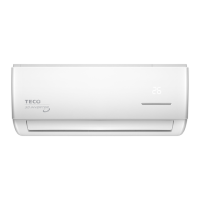NOTE ON ILLUSTRATIONS
Illustrations in this manual are for explanatory purposes. The actual shape of your indoor unit
may be slightly different. The actual shape shall prevail.
NOTE: For detailed explanation of each function and advanced functionality
(such as TURBO mode and its self-cleaning functions), please refer to the
Remote Control User's Manual.
Other Features
Unit
Specifications
and Features
Page 8
• Auto-Restart
If the unit loses power, it will automatically restart with the prior settings once power has
been restored.
•
Simply Smart Air Wireless Control
(optional TECO Wireless Kit model: TWFMODVEM )
Simply Smart Air wireless control allows you to control your air conditioner using
your smart phone and Internet connection.
•
Louvre Angle Memory
When turning on your unit, the louvre will automatically resume its former angle.
•
Refrigerant Leakage Detection
The indoor unit will automatically display “EC” when it detects refrigerant leakage.
•
DR Control (Demand Response Capability)
This product is designed to be compatible with your Energy Supplier’s Demand
Response Control Program (if implemented). If you are taking part in this
program, the Energy Supplier’s Demand Control Signal Receiver (DCSR), will be
installed in your system outdoor unit by your installer.
If a Demand Response signal is received from your energy supplier, the power
consumption of your system will be reduced depending on the signal mode
received.
During a Demand Response period, the indoor unit display area will display d1, d2
or d3. Please see table below for details of each mode.
If a DR signal input malfunction occurs the display area will display dE and the system
will operate normally. When the system is in a DR mode, the cooling or heating effect
of the system may be slightly reduced.
DR mode
DR mode 1 Compressor off.
The air conditioner continues to cool or heat during the demand response event, but the total electrical energy (kWh) consumed
by the air conditioner in a half hour period is not more than 50% of the total electrical energy that would be consumed in a half
hour period during normal operation under the same temperature and humidity conditions, and the same user settings.
The air conditioner continues to cool or heat during the demand response event, but the total electrical energy (kWh) consumed
by the air conditioner in a half hour period is not more than 75% of the total electrical energy that would be consumed in a half
hour period during normal operation under the same temperature and humidity conditions, and the same user settings.
DR mode 2
DR mode 3
Description of operation in this mode

